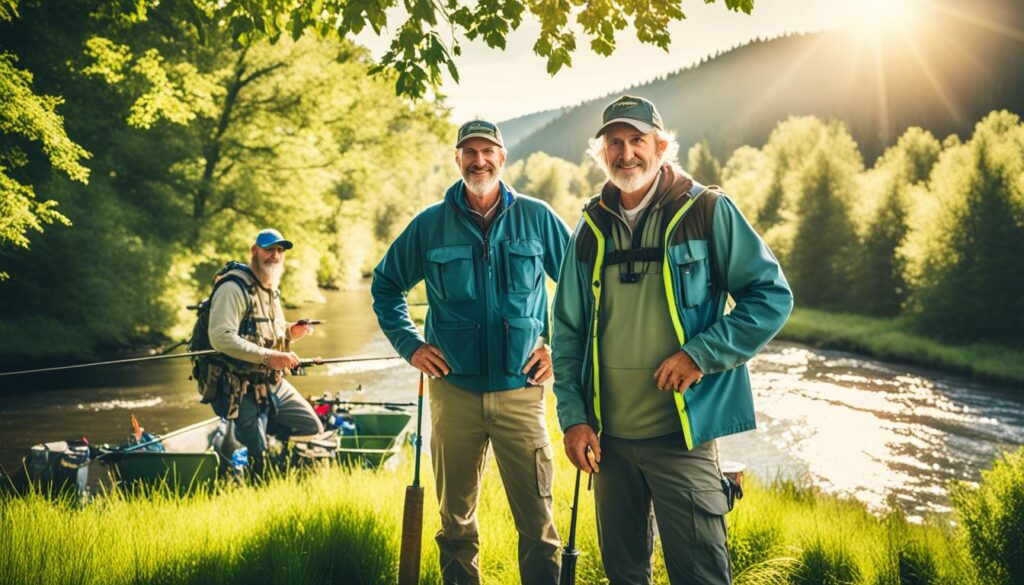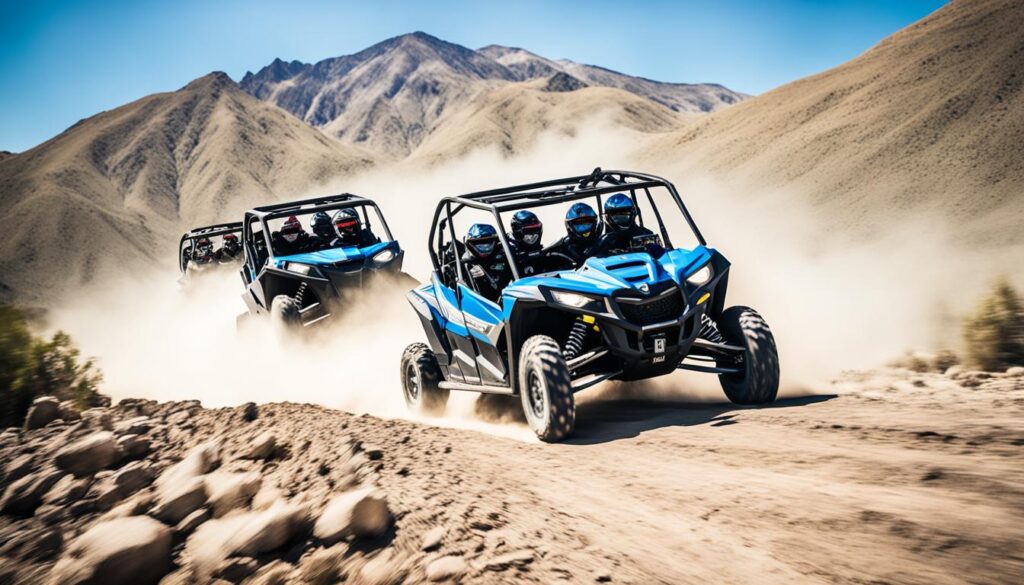As a beginner angler, diving into the world of fishing can seem overwhelming. With so many options for gear and techniques, it’s difficult to know where to start. In this article, I will provide essential tips and gear recommendations specifically tailored to fishing beginners. Whether you’re interested in freshwater or saltwater fishing, this guide will help you get started on your fishing journey.
Before we delve into the details, let me introduce myself. My name is [Your Name], and I have been an avid angler for [number of years]. Throughout my fishing experiences, I have gathered valuable knowledge and insights that I want to share with you. I understand the challenges that beginners face and aim to make your fishing experience enjoyable and successful.
When it comes to fishing gear, it’s crucial to have the right equipment for the job. From rods and reels to lines and hooks, each component plays a vital role in your fishing success. In the following sections, I will guide you through the process of choosing the right fishing rod and reel, selecting the appropriate fishing line, understanding hooks and floats, and building a basic lure collection. I will also provide recommendations for essential fishing tools and give insights into fishing knots and safety measures.
Throughout this article, I will use my expertise to simplify complex concepts and provide practical advice suitable for beginners. So, whether you’re fishing from the shore or venturing out on a boat, you can feel confident in your gear choices and fishing techniques.
Are you ready to embark on an exciting fishing adventure? Let’s dive in and explore the essential tips and gear you need as a fishing beginner.
Key Takeaways:
- Choosing the right fishing gear is crucial for a successful fishing experience.
- Start with a light-power, fast-action fishing rod and a reel with an excellent drag system for smooth line release.
- Monofilament fishing line is recommended for beginners due to its abrasion resistance and knot strength.
- Understanding hooks and floats is essential for fishing with live bait effectively.
- Invest in a good pair of fishing pliers for various tasks like removing hooks and cutting wire for leaders.
Contents
- 1 Choosing the Right Fishing Rod and Reel
- 2 Selecting the Right Fishing Line
- 3 Understanding Hooks and Floats
- 4 The Importance of Fishing Pliers
- 5 Building a Basic Lure Collection
- 6 Essential Fishing Knots
- 7 Getting Started with Freshwater Fishing
- 8 Practicing Catch and Release
- 9 Fishing Safety Tips
- 10 Conclusion
- 11 FAQ
- 12 Source Links
Choosing the Right Fishing Rod and Reel
When it comes to beginner fishing gear, choosing the right fishing rod and reel is essential. As a beginner angler, you’ll want to start with a light-power, fast-action rod. This type of rod offers the versatility and sensitivity necessary to catch a variety of fish species, from Bluegill and Crappie to Perch, Trout, Smallmouth Bass, Largemouth Bass, and Walleye.
As for the reel, it’s important to select one with an excellent drag system for smooth line release and line capacity that suits your fishing needs. Here are two popular options:
1. St. Croix Premier: This high-quality rod and reel combo offers exceptional performance and durability. It features a lightweight design, sensitive graphite rod, and a smooth-operating reel with a reliable drag system.
2. Ugly Stik Elite: Known for its durability and affordability, the Ugly Stik Elite is a favorite among beginner anglers. It boasts a strong and sensitive graphite rod paired with a reliable reel that provides a smooth fishing experience.
Both the St. Croix Premier and Ugly Stik Elite are excellent options for beginners seeking reliable and versatile fishing gear.
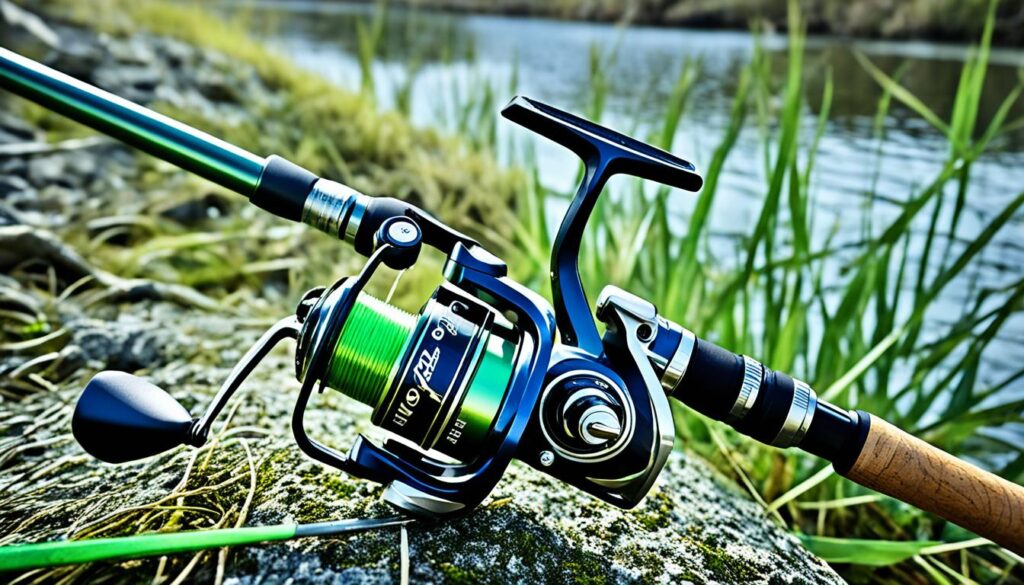
| Fishing Rod | Fishing Reel |
|---|---|
| Light-power, fast-action rod | St. Croix Premier |
| – | Ugly Stik Elite |
Selecting the Right Fishing Line
As a beginner angler, it’s crucial to select the right fishing line that suits your needs. The fishing line is an essential component of your setup, connecting you to the fish and ensuring a successful catch. For beginners, monofilament line is often the best choice.
Monofilament line offers several advantages that make it ideal for beginners. Firstly, it is abrasion-resistant, which means it can withstand the wear and tear of fishing in various environments. Secondly, monofilament line ties easily, making it convenient for beginners who may be less experienced with knot tying. Lastly, monofilament line provides excellent knot strength, ensuring that your knots hold tight when you hook a fish.
Another benefit of using monofilament line is its shock resistance during fights with fish. When a fish makes sudden movements or tries to escape, monofilament line absorbs the shocks and prevents it from breaking easily.
When selecting the pound test for your monofilament line, it’s important to consider your rod and reel setup. Aim for lines between four- and eight-pound monofilament test, depending on the type of fish you are targeting and the strength of your rod and reel. Lighter lines are suitable for smaller fish species, while heavier lines are required for larger, more powerful fish.
Remember, the fishing line is the connection between you and the fish, so it’s important to choose a line that suits your fishing style and target species. By selecting the right fishing line, you’ll enhance your chances of success and enjoy a more rewarding fishing experience.
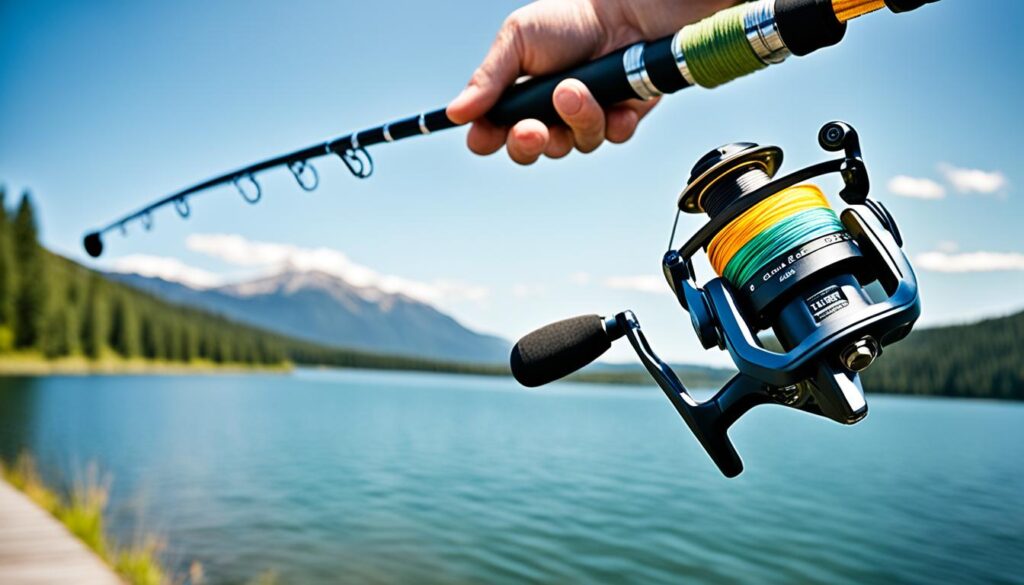
Understanding Hooks and Floats
Hooks and floats are essential components in the world of fishing, particularly when using live bait. Choosing the right hook size and type is crucial for successfully catching different fish species. Here’s a breakdown of the recommended hook sizes for various common fish:
Bluegill, Sunfish, Perch, and Trout: Size #6 and #4 baitholder hooks
Crappie: Light-wire Aberdeen hooks in sizes ranging from #4 to #2
Catfish and Speckled Trout: Circle hooks
When it comes to using live bait, slip floats are highly effective. These floats can be easily reeled up to the end of your rod, allowing for precise and accurate casts. They are particularly useful for anglers starting their fishing journey and are looking to improve their casting skills.
Now, let’s take a closer look at these hooks and floats:
1. Baitholder Hooks
Baitholder hooks are ideal for securing live bait in place. They feature two barbs on the shank of the hook, preventing the bait from slipping off during casting or when a fish bites. These versatile hooks work well for Bluegill, Sunfish, Perch, and Trout, making them an excellent choice for beginners.
2. Aberdeen Hooks
Aberdeen hooks, with their thin wire construction, are perfect for Crappie fishing. Their light-wire design allows for easy hook penetration, ensuring a higher hookup ratio. Available in sizes ranging from #4 to #2, Aberdeen hooks are versatile enough to catch other fish species as well.
3. Circle Hooks
Circle hooks are designed to hook fish in the corner of their mouth, reducing the risk of gut hooking. These hooks are great for larger predatory fish like Catfish and Speckled Trout. Their unique shape increases the chances of a successful catch while minimizing harm to the fish.
4. Slip Floats
Slip floats are an angler’s best friend when it comes to suspending live bait at a specific depth. These adjustable floats can be easily moved up and down the fishing line, allowing you to present your bait at the desired level. Slip floats are especially effective for fishing in deeper waters or when targeting fish in specific areas.
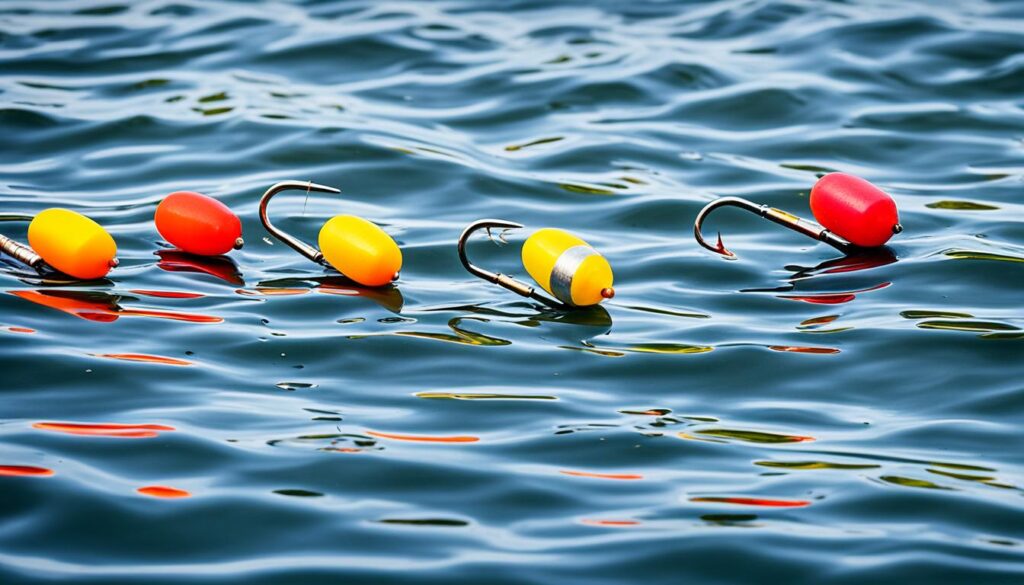
| Hook Type | Recommended Fish Species |
|---|---|
| Baitholder Hooks | Bluegill, Sunfish, Perch, Trout |
| Aberdeen Hooks | Crappie |
| Circle Hooks | Catfish, Speckled Trout |
Choosing the right hook and float combination will significantly improve your chances of landing a successful catch. Experiment with different sizes and types to find what works best for you and the fish you’re targeting.
The Importance of Fishing Pliers
Fishing pliers are essential tools for anglers. They play a crucial role in various fishing tasks, making them a must-have item in any angler’s tackle box.
One of the primary uses of fishing pliers is placing and removing split shots. Split shots are small weights that help sink the fishing line and keep the bait at the desired depth. Fishing pliers with a split shot crimping feature make it quick and effortless to secure the weights in place.
Fishing pliers also come in handy when it comes to removing hooks from a fish’s mouth. With their long nose and spring jaws, fishing pliers allow anglers to reach deep into the fish’s mouth without getting their hands too close to sharp teeth or spines. This makes the hook removal process safer and less stressful for both the angler and the fish.
“Fishing pliers can be a game-changer for anglers, offering convenience and functionality for various fishing tasks.”
In addition to placing and removing split shots and hook removal, fishing pliers are essential for cutting wire. Whether you need to trim a leader line or cut through thick wire when rigging up certain types of bait, fishing pliers with cutting power are indispensable.
When selecting fishing pliers, look for a pair with a comfortable grip that allows for easy handling. Spring jaws are also beneficial as they automatically open the pliers after each use, saving you valuable time and effort. A durable construction is important, ensuring that your fishing pliers can withstand the wear and tear of regular use.
| Feature | Recommended Fishing Pliers |
|---|---|
| Comfortable Grip | KastKing’s Cutthroat 7-inch Fishing Pliers |
| Spring Jaws | KastKing’s Cutthroat 7-inch Fishing Pliers |
| Cutting Power | KastKing’s Cutthroat 7-inch Fishing Pliers |
*Please note that brand preferences may vary among anglers, and there are other reliable options available in the market.
Investing in a quality pair of fishing pliers is a wise choice for any beginner angler. They will prove to be invaluable when it comes to performing essential fishing tasks, ensuring a more efficient and enjoyable fishing experience.
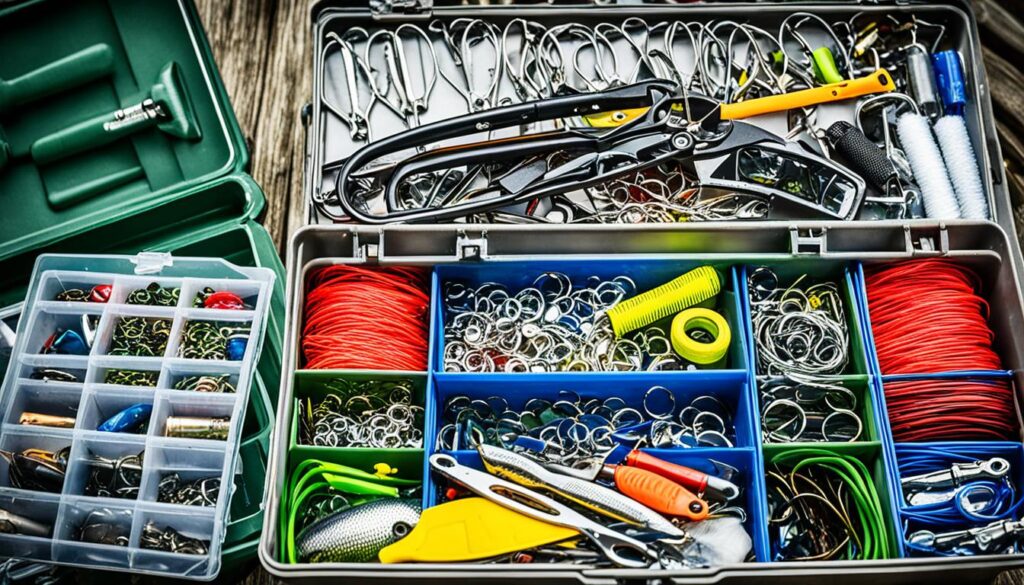
Building a Basic Lure Collection
As a beginner angler, starting your fishing journey with a few carefully chosen lures can make all the difference. These lures are not only effective but also easy to use, making them perfect for beginners. Here are three highly recommended lures to include in your basic lure collection:
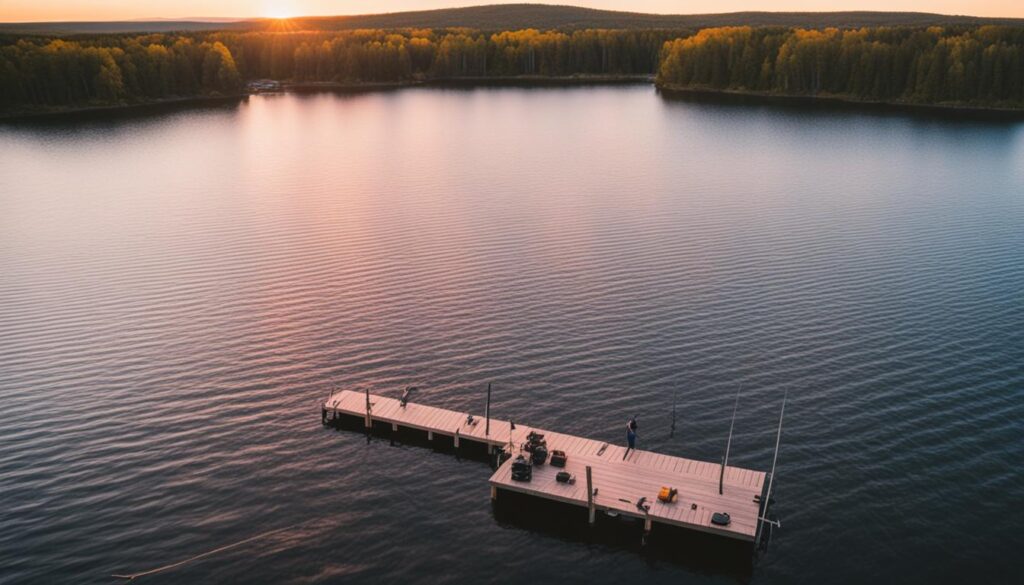
1. Wordens Original Rooster Tail
This popular lure has been catching fish for over 60 years and remains a favorite among anglers. The Wordens Original Rooster Tail features a spinning blade that mimics the movement of a small fish or insect, attracting a variety of fish species. It is especially effective for trout, bass, panfish, and walleye.
2. Rapala Original Floater
The Rapala Original Floater is a classic lure that has stood the test of time. Its lifelike swimming action and realistic color patterns make it irresistible to fish. This lure works well for a wide range of fish species, including bass, trout, pike, and walleye.
3. Strike King's Chrome Sexy Shad
The Strike King’s Chrome Sexy Shad is a versatile lure that imitates the appearance of a wounded baitfish. Its flashy design and realistic swimming action attract predatory fish, making it suitable for bass, pike, muskie, and other gamefish.
By adding these lures to your collection, you’ll be equipped with versatile and proven options to entice various fish species. Experiment with different colors, sizes, and retrieval techniques to find what works best for your local fishing spots.
Essential Fishing Knots
Learning a few essential fishing knots is crucial for success. As a beginner angler, knowing how to tie the right knots will ensure that your lures and hooks are securely attached to your fishing line. Here are three must-know knots:
- The improved clinch knot is widely considered one of the most reliable knots for attaching hooks, lures, and swivels. It is a simple knot that provides excellent strength and reliability.
- The palomar knot is another highly recommended knot. It is known for its superior strength and is particularly useful when attaching lures with small eyelets or when fishing with braided lines.
- The uni knot is a versatile knot that can be used for a variety of applications, including attaching lures, hooks, and swivels. Its strength and ease of tying make it a favorite among many anglers.
Before your fishing trip, take the time to practice tying these knots. Familiarize yourself with the steps and ensure that you can tie them quickly and securely. Having confidence in your knot-tying skills will give you peace of mind on the water and increase your chances of landing that trophy fish.
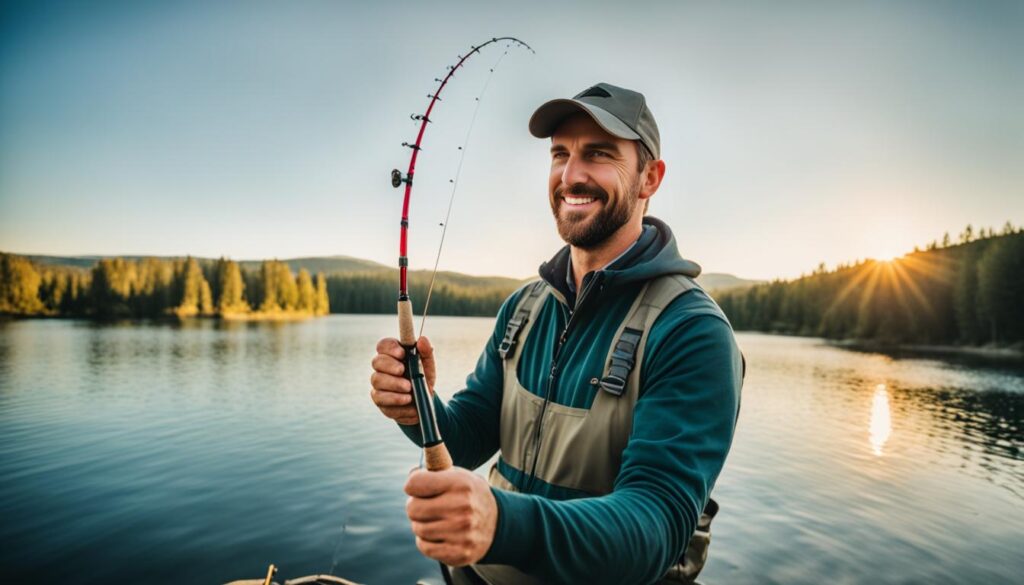
“Tying a good knot is as important as using the right bait. A poorly tied knot can cost you your catch.”
– Expert Angler
Getting Started with Freshwater Fishing
Before you embark on your freshwater fishing adventure, there are a few important steps to take. First, ensure that you have a valid state fishing license if required. This is essential for legal and responsible fishing.
Next, gather all the necessary fishing gear to ensure a successful fishing experience. Here’s a list of items you’ll need:
- A fishing rod and reel
- Monofilament fishing line
- Fishing weights
- Fish hooks
- Bobbers
- Live bait or fishing lures
Having the right equipment will greatly enhance your chances of catching fish. Don’t hesitate to seek advice from experienced anglers or visit local bait and tackle shops to get recommendations on gear that works well for beginners.
Once you have your gear, take the time to familiarize yourself with the fishing laws and regulations in your area. Each state has its own rules and restrictions, including bag limits, size limits, and specific fishing seasons. Knowing and adhering to these regulations ensures the conservation of fish populations and protects the ecosystem.
“Respecting the rules and regulations of fishing not only ensures that we preserve fish for future generations but also helps maintain the delicate balance of our freshwater ecosystems.” – [Your Name]
By following these guidelines and taking the necessary precautions, you’ll be ready and equipped for an enjoyable freshwater fishing experience.
Tips for Choosing Fishing Gear:
| Type of Gear | Recommendation |
|---|---|
| Fishing Rod and Reel | Start with a medium-light power, fast-action rod for versatility. Consider brands like St. Croix Premier or Ugly Stik Elite. |
| Fishing Line | Opt for four- to eight-pound monofilament line for beginners. It offers good knot strength and shock resistance. |
| Fish Hooks | Choose appropriate hook sizes and types based on the target fish species. Size #6 and #4 baitholder hooks work well for Bluegill, Sunfish, Perch, and Trout. |
| Live Bait or Fishing Lures | Start with a few versatile lures such as Wordens Original Rooster Tail, Rapala Original Floater, and Strike King’s Chrome Sexy Shad. |
Practicing Catch and Release
Respecting catch and release practices is essential for conservation. When catching a fish that doesn’t meet legal size requirements or that you don’t plan to keep, handle it with care and release it quickly. Keep the fish wet to minimize stress and damage to its scales. Avoid tearing the hook out if it’s swallowed. Instead, gently remove the hook with pliers or a hook removal tool to minimize injury. Remember to always handle the fish with wet hands or use a wet cloth to protect its slime layer.
After removing the hook, gently support the fish in its natural swimming position and submerge it in the water. Allow the fish to regain its strength and swim away on its own. Minimize airtime to prevent excessive exhaustion. If necessary, revive the fish by gently moving it back and forth in the water. Observe the fish until it swims away confidently.
In addition, it’s important to use proper fishing gear that minimizes harm to the fish. Barbless hooks are recommended as they can be easily removed without causing excessive damage. Using a landing net with a soft mesh can also reduce the risk of injuring the fish’s sensitive slime layer.
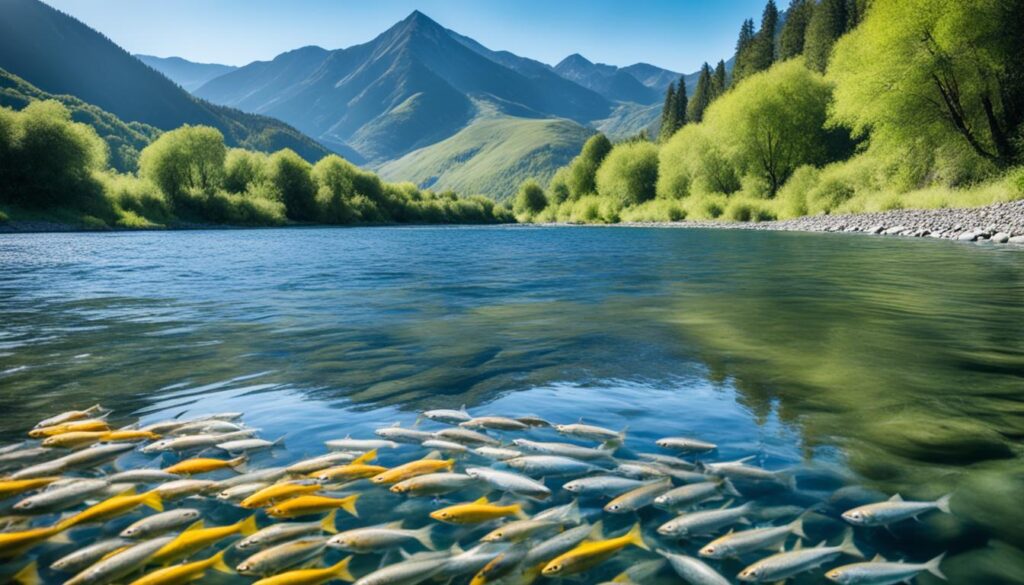
Fishing Safety Tips
Fishing safety should always be a top priority when you’re out on the water. Whether you’re a beginner or an experienced angler, taking the necessary precautions can help ensure a safe and enjoyable fishing experience. Here are some essential fishing safety tips for beginners:
Fish with a Companion
When possible, it’s advisable to fish with a companion. Having someone else with you can provide an extra layer of safety and assistance in case of emergencies. Additionally, fishing with a buddy can make the experience more enjoyable and memorable.
Handle Sharp Hooks with Caution
Sharp hooks are an essential tool in fishing, but they can also pose a risk if mishandled. Always exercise caution when handling hooks to avoid accidental injuries. Use proper techniques to remove hooks from fish or bait, and be careful when storing or transporting fishing gear to prevent accidental hook injuries.
Avoid Casting Near Other People
When casting your line, be mindful of your surroundings and avoid casting near other people. Make sure you have enough space to safely cast without risking injury to yourself or others. Communication and awareness are key to preventing accidents and ensuring a safe fishing environment.
Wear a Personal Flotation Device
Whether fishing from the shore, a boat, or wading in the water, wearing a personal flotation device (PFD) is crucial for your safety. A PFD can help prevent accidents and provide buoyancy in case of an unexpected fall or emergency. Choose a comfortable and well-fitting PFD that meets safety requirements.
Practice Good Conservation Ethics
As responsible anglers, it’s essential to practice good conservation ethics. Avoid leaving behind plastic containers, fishing line, or any other waste that can harm the environment and wildlife. Additionally, refrain from moving fish or plants between water bodies to prevent the spread of invasive species.
By following these fishing safety tips, you can minimize risks and ensure a safe and enjoyable fishing experience. Remember to fish responsibly, respect the environment, and prioritize the safety of yourself and others.
Conclusion
Fishing for beginners is an exciting and fulfilling outdoor activity. With the essential tips and gear recommendations provided in this fishing for beginners guide, you will be well-prepared to embark on your fishing journey. It is important to choose the right rod and reel, select the appropriate fishing line, understand hooks and floats, and have essential tools like fishing pliers at hand.
Building a basic lure collection and mastering essential fishing knots will enhance your chances of success. Familiarizing yourself with fishing regulations and practicing catch and release not only ensure the sustainability of our fisheries but also contribute to the preservation of our ecosystems.
Lastly, prioritize fishing safety by fishing with a companion, wearing a personal flotation device, and practicing good conservation ethics. By following these guidelines, you can embark on a fishing adventure filled with memorable experiences and the joy of reeling in your first catch. So, grab your gear, head to your favorite fishing spot, and enjoy the thrill of fishing!
FAQ
What type of fishing rod and reel should I choose as a beginner?
It’s best to start with a light-power, fast-action rod and a reel with an excellent drag system and suitable line capacity.
What fishing line is recommended for beginners?
Monofilament line is often the best choice for beginners due to its abrasion resistance, easy tying, and shock resistance.
What hooks and floats should I use?
Different fish species require different hook sizes and types. Slip floats are recommended for suspending live bait.
Why are fishing pliers important?
Fishing pliers are essential tools for tasks like placing and removing split shots, reaching into a fish’s mouth, and cutting wire.
How can I build a basic lure collection?
Start with highly effective lures like Wordens Original Rooster Tail, Rapala Original Floater, and Strike King’s Chrome Sexy Shad.
What are some essential fishing knots to know?
Essential fishing knots include the improved clinch knot, palomar knot, and uni knot for attaching lures and hooks to your line.
What do I need to get started with freshwater fishing?
You’ll need a fishing rod and reel, monofilament fishing line, fishing weights, fish hooks, bobbers, and live bait or lures. Additionally, check and abide by fishing laws and regulations.
How should I practice catch and release?
Handle fish with care, keep them wet, minimize airtime, and avoid tearing the hook out if it’s swallowed. Revive the fish gently before releasing it.
What are some fishing safety tips for beginners?
Fish with a companion whenever possible, handle sharp hooks with caution, wear a personal flotation device when necessary, and practice good conservation ethics.
